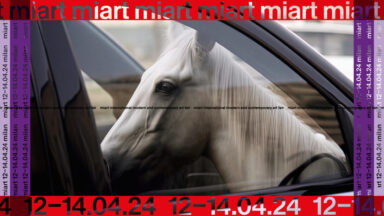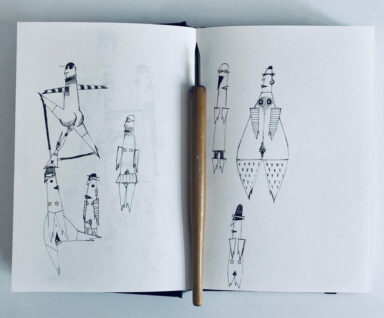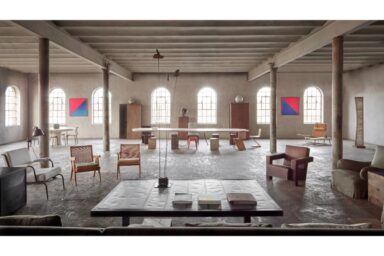HANS Op DE BEeCK GUiDEs US, ExCEPTIONaLLY, THROuGH A VIRtUAL TOuR OF HIS MoNUMENTaL EXHIBiTION aT THE KuNSTHaLLE KREmS IN AuSTRIA
Curated by: Valentina De’ Mathà
Belgian sculptor, painter, photographer, director, screenwriter, composer and playwright, all this is gathered in Hans Op de Beeck. His work takes us into a timeless world, in-between dream and reality and contemplative silences, with a tragicomic gaze exploring life and the finality of death.
Here’s what we saw through his eyes…
VDM: This March you’ve inaugurated an extensive retrospective entitled ‘Hans Op de Beeck: The Cliff’ at the Kunsthalle Krems, with an audience of about 1,400 people only during the opening day. Monumental installations, videos, paintings, sculptures… Do you mind accompanying us with a detailed description?
HODB: The show opens with the sculptural work ‘My bed a raft, the room the sea and then I laughed some gloom in me’ (2019). It is a sculpture of a life-sized sleeping girl on a bed that hovers above a raft, which floats on a dark water surface with sculpted water lilies and reeds.
The work starts from a personal childhood experience of mine: as a child, I often imagined my bed was a raft on the water, and the surrounding night-dark room the sea or a lake. When I went to sleep, I then surrendered to my soft raft, with an emergency ration of comic strips, some candy and a flashlight to read. The girl in the sculpture lies on her back, in full surrender to the sleep. There are butterflies sitting here and there on the blankets; fantasy elements from the dream world in which she finds herself. Next to her is a stack of books, which also contains a glass of water and some sleeping pills. The girl’s mattress visually hovers above the raft, because it is in her dream that both worlds, that of her bedroom and that of her dream merge in a surreal way.
The sculpture is life-sized, so that the viewer physically relates to the figure. Because the girl sleeps, the viewer is the silent voyeur who watches her.
A raft, after all, is a nice metaphor for surrender. It is not a boat that you control yourself, but a floating rectangle that is controlled by chance and the elements of nature. Letting it float, being adrift, is a feeling that I associate with sleep, just as much as hovering. Both elements come together in the sculpture.
The exhibition then continues with seven separate screening rooms for video works.
‘Parade’ (2012) is a video I filmed on the stage of a theatre. The red velvet curtain opens, a slow waltz, composed especially for this film, starts playing, while a seemingly endless cavalcade of people comes walking by from the left to the right on the stage, in slow motion, like a stream of passers-by in a street. This parade of most diverse characters and outfits can be seen as a rather commonplace event, yet to me it is a fundamental, visual reflection on life and death as well.
The video ‘Celebration’ (2008) was shot in the natural landscape near Phoenix, Arizona. It features a front-on view of a festively bedecked table in a strange location: the middle of a desert landscape of imposing rocks, sun-baked earth and cactus plants. The scene is a real tableau vivant, where the only movement is the rustling of the tablecloth in the breeze. Time also seems to be immobile, frozen in the moment prior to the celebration, possibly that of a kitschy wedding anniversary. Everything is ready; the festivities are about to begin. But the scene conveys a sense of emptiness, as if the party will inevitably be disappointing.

The video ‘Staging Silence (2)’ (2013) is based on abstract, archetypal settings that lingered in my memory as the common denominator of the many similar public places I have experienced. The video images are both ridiculous and serious, much like the eclectic mix of pictures in our minds. The decision to film in black and white emphasises this ambiguity: the amateurish quality of the video evokes the legacy of slapstick as well as the insidious suspense and latent derailment of the film noir. The title refers to the staging of such dormant decors onto which the spectator, in the absence of other figures, can project himself as the lone protagonist. Remembered images are disproportionate mixtures of concrete information and fantasy, and in this film, they materialise before the spectator’s eyes by means of anonymous tinkering actions and improvising hands. Arms appear and disappear at random, manipulating banal objects, scale representations and artificial lighting to create alienating, yet recognisable, locations. These places are nothing more than animated decors for possible stories, evocative visual propositions, to be experienced by the spectator.
‘The Girl’ (2017) is a slow, suggestive, perception-oriented animated film in which the viewer is transported to the strange world of a silent, 14-year-old girl.
The dreamy landscape images show a dark forest, a vast landfill, a gas station, a highway landscape, a meadow, a factory site and a mysterious lake. Amidst all this stands an old caravan. The scene seems to suggest that the protagonist leads a lonely life on these premises. For a further unspecified reason, she must at one time have left her parental home, which is presented to us at the beginning of the film, both in perfect condition, and later in a neglected, abandoned state.
In a variety of different landscapes, we see the girl perform small acts such as gathering usable waste or picking herbs. We often get to see her cargo bike; the vehicle she uses to gather the bare necessities in order to survive. Night-time, breaking dawn, wind, rain, fog, cold and warming fire are present throughout the film. Occasionally, we get to see the girl – resting serenely – from up close, as if we were right beside her, and could feel her breath.
At the end of the film we understand that she is resting on a raft in the lake, floating, passive, as a metaphor for surrender.
The film ‘The Thread’ (2015) follows two punk puppets, an Asian boy and a Caucasian girl, as they play out their sober love story. Like the puppets in Japanese Bunraku theatre, my characters are almost life-sized and are operated almost choreographically by anonymous puppeteers in black from head to toe as they enact the dramatic tale.
There are no words in the film; everything is expressed by suggestion in a tender boy-meets-girl story reduced to its essence. Halfway through we see their first kiss, only to realise, as their lips part, that sixty years have passed. The film ends with the death of one puppet in the lap of the other, released by the puppeteers and therefore lifeless.
As befits the Bunraku tradition, the film tells a tragic love story that reflects on death and loss.
‘Dance’ (2013) is a fairly abstract video about people in motion, about power and powerlessness and about the tragedy of what appears to be the total interchangeable nature of the individual in the grand scheme of things. The title itself, ‘Dance’, refers to migration as an unsteady, rhythmically irregular movement, a balancing act. I directed a group of 800 costumed volunteers in a huge, vacant factory warehouse. The video was made with four moving cameras recording simultaneously from different angles. In the film, this ensemble cast all perform a silent and synchronised sequence of extremely simple movements, like a choreography of everyday activities. The banality of each small movement is magnified by the collective effort. A group of hundreds of collectively showering or sleeping people is highly evocative. The absence of concrete scenery, the lack of text or narrative and the stylised movements create a very specific atmosphere. This is a video about people leaving everything behind, either because they can or because they have to. In a subtle way, I try to touch on both voluntary and forced migration, on the refugee in search of a better future but also on deportation and exile. The size of the group of performers suggests that the individual story of each refugee or migrant is, at the same time, a collective story.
‘Night Time’ (2015) is an animated film, monochromatic, full of artificial lights and shadows, with no text, based on my on-going series of large black and white watercolour paintings. The nocturnal is a palpable presence in the natural and urban landscapes, the buildings, interiors and characters that bring the film to tenebrous life.
I conceived ‘Night Time’ as a mysterious dream in which proportions, perspectives and environments are all fictitious. Intimate close-ups segue into panoramic images and vice versa, each image manifests a meticulously crafted construction. The film has a restful rhythm but is also latent with the dissipation typical of the hours of darkness.
Classic and distinctly contemporary subjects follow one another: the dream, the sleep, the underworld, the exploding postmodern metropolis, sexuality, tattoo culture, refined traditions of dress, rituals, ageing, partying, death… The film is a mix of both the highly cultivated and the raw subcultural.
After these seven video screening rooms, the viewer enters a space with sculptural works.
‘Blackberries’ (2019) is a composition of three totally oversized blackberries on a cylindrical pedestal.
When I was a kid, my brother and I used to pick blackberries in the summertime, and my mother then made her stiff, overly sweet jam out of them.
Blackberries are my Proustian madeleine: when the first ripe blackberry melts on my tongue in the summer, it awakens something in me, and I find myself instantly transported back to my youth. Oversized, life sized or on reduced scale, the blackberry, something I consider a perfect jewel from nature, returns in many of my works.
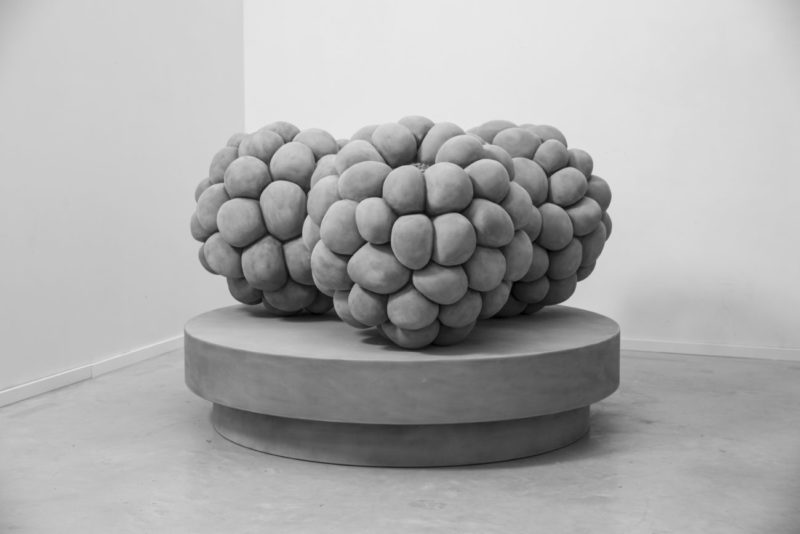
In the same room I installed two works of my ‘Wunderkammer’ series. These two showcases, made at my studio, both display a collection of rarities and banalities in a most associative manner. The series of showcases refer to the old tradition of the Wunderkammer, in which many subjectively collected, anachronistic and eclectic objects deriving from all kinds of cultural backgrounds are put together and displayed in a treasure house way.
‘Memento Mori’ (2019) is an oversized sculpture that depicts a half-eaten birthday cake. A birthday cake in my view is the ultimate memento mori. We human beings seem to have the strange habit to celebrate our own mortality yearly. This monochromic grey, disproportionally large sculpture appears as a petrified object.
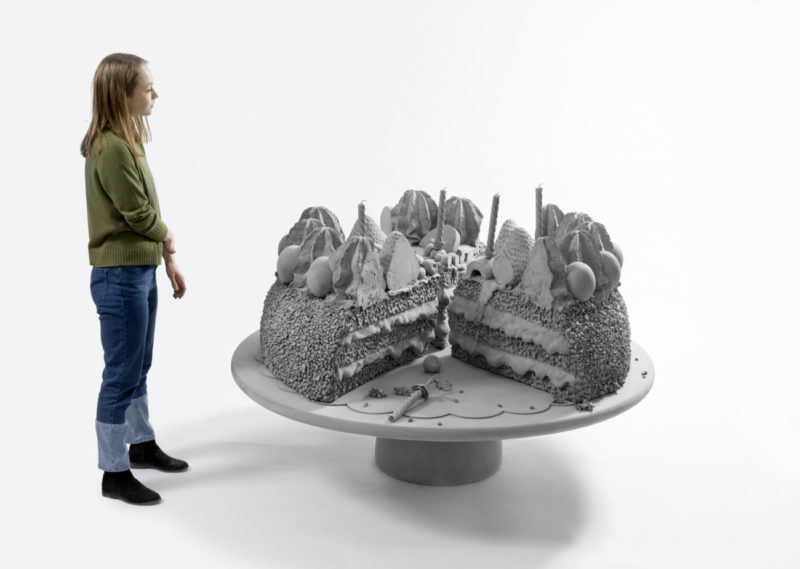
‘Christmas’ (2006) is a sculpture that depicts a spic-and-span living room. The immaculate room has been prepared for the Christmas celebration. The large-scale model represents an imaginary living room. The entire space has been finished in a gleaming metallic black lacquer; the style of the interior is reminiscent of interior design schemes from the seventies, eighties or nineties.
This space, done on scale, is animated by artificial light that enters the room through a large window part; it looks like the orange light of streetlights. With this work I wanted to stage a nocturnal mood, where the innocent Christmas scene becomes gloomy. The domestic setting is a place for the joy of shared moments and rituals, but it is the setting for trauma and difficulties as well.
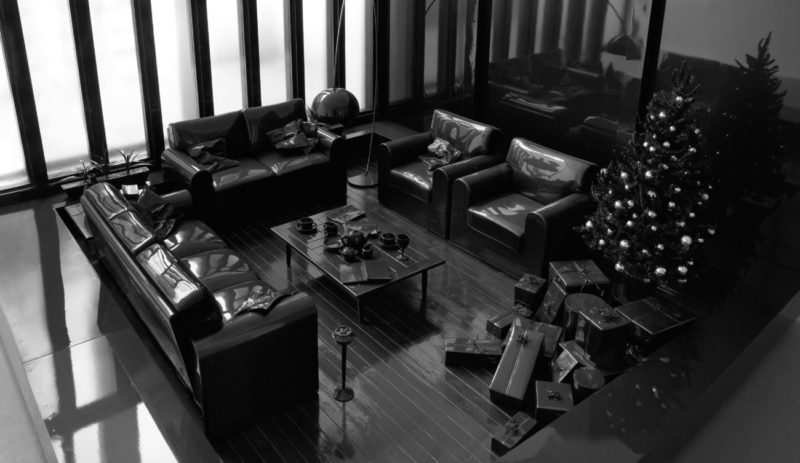
After this room, the spectator meets a series of life-sized sculptures of children.
Since a couple of years, I started creating these monochrome grey works. The characters all have their eyes closed, as if they find themselves in a quiet moment of concentration, meditation or introspection. The acts they perform are banal, daily life like.
In ‘Tatiana (soap bubble)’ (2018), a girl blows a soap bubble. ‘Timo (marbles)’ (2018) is a boy sitting on the floor, that is about to shoot away a marble. ‘Timo’ (2018) is a sculpture of a boy that is about to shoot a toy arrow from his tensed bow. ‘Brian’ is a boy meditatively seated on the floor, cross-legged, holding a glass ball in his hands.
In the next space, I installed the work ‘Sleeping Girl’ (2018). This is a life-sized sculpture of a young girl sleeping on a sculpted Chesterfield sofa. The surrounding room is decorated with carpet and panelling on the walls, as if it were a lounge or a part of a wide corridor where the girl fell asleep.
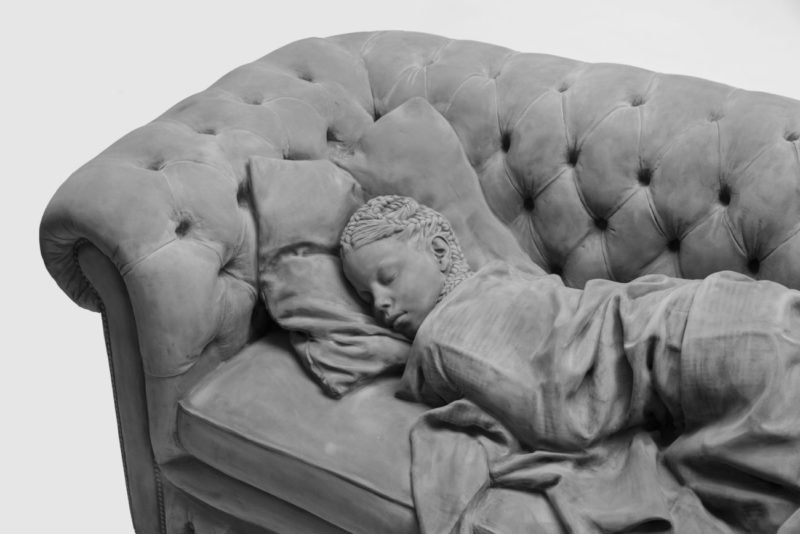
Then the show continues with two rooms with a selection of large watercolour paintings on paper.
Since 2009 I painted about 400 large black and white watercolour paintings, most of them about three-meter wide. Except for one, all watercolours were used in my animated film ‘Night time’, of which I spoke about extensively before.
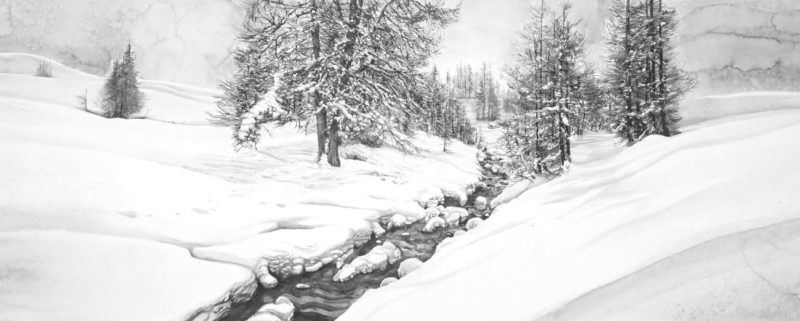
And the end of the exhibition, the viewer enters the large, final space, for which I created the largest piece of the show – dimensions wise.
‘The Cliff’ is a large-scale sculptural installation. For the first time I created an immersive installation that combines the life sized human figure with a sculpted natural landscape. The work consists of a monumental sculpture of a long, high, rocky cliff on which, at the very end, well hidden, a couple of two 14-year old teenagers are seated. A skinny boy is holding hands with a girl and staring at her, seemingly totally in love with his first girlfriend. The girl though, stares into the distance, supposedly towards the horizon of the sea, her thoughts transported elsewhere, seemingly not in touch with the boy.
So far, I solely created life-sized sculptures of people with eyes closed. For the first time these two teenagers have their eyes opened. The sculpting of the gazes of both teenagers was a new step within this part of my multi-disciplinary art practice.
The audience can walk around the sculpted natural landscape and can have the experience of a shifting perspective on this frozen scene that has references to cinema; as if it were a frozen moment of a motion picture, executed in three dimensions.

For me, be it in my sculptural work, my play writing and directing or my film work, a generous invitation for identification with the protagonists by the audience is most essential. Every teenager or adult can identify with these big feelings that go with puberty, with that first being in love, and all the misunderstandings, broken hearts and clumsiness that come with it.
“Hans Op de Beeck: The Cliff”
Kunsthalle Krems
Austria
From March 3 to June 23
Hans Op de Beeck portrait by Christophe Vander Eecken
“The Cliff” series by Christian Redtenbacher
All the other pictures by Studio Hans Op de Beeck
Cover: “The Cliff” by Hans Op de Beeck, Photo Christian Redtenbacher



































































